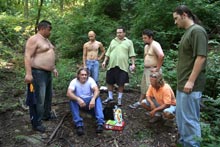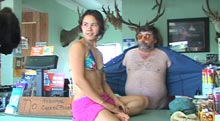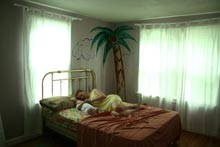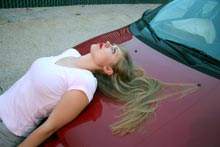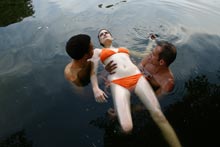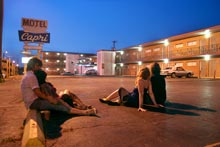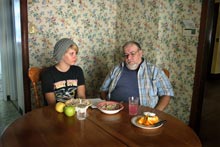 |
   |
| Laurel Nakadate Stay the Same Never Change February 1 - March 15, 2008 The girl who knew too much Laurel Nakadate is trouble. There are no two ways about it, this girl is dangerous and knows too much and if we’re not careful she’ll probably take us all down with her. For several years now, Ms. Nakadate has been creating her own unnerving, devious and quietly subversive artistic landscape and while she doesn’t seem to mind if we visit (hell, I don’t think she minds if we sit on the edge of the bed and watch) she doesn’t really seem to care much, either. She is an absolute original and a genuine ‘naughty girl.’ As a performing artist, Ms. Nakadate has always been something of a tease. She’s too old to be a full-on ‘Lolita’ but she’s absolutely perfect in the role of the new step-sister who keeps leaving her door open while she’s changing in the bedroom across from yours. Her work asks you to observe—she never begs but a lot of the lonely males who populate her videos do (along with a fair share of her audience, I’m guessing)—and every so often she throws an inscrutable glance toward the camera but she doesn’t seem to get off on it. As a step-sibling the girl would be happy to lead you straight to Hell, but as an artist she is as powerful and as adventurous a new voice as we have in present-day America. I’m not known for my hyperbole—I speak highly of the person because she deserves it. And now there is Stay The Same Never Change to deal with. This is a giant step forward for any artist, to move so successfully into another medium at the height of their career. Like all great artists, though, Ms. Nakadate is more than up to the challenge; she takes the medium by the hand and leads it off into the woods to do strange and unspeakable things to it. This film is a quiet and beautiful creature, filled with the moody silence of modern neighborhood life and the serenity and terror of childhood. I can’t think of a filmmaker who has captured ordinary people (non-professional actors) in a fictional form with this kind of success probably since Harmony Korine made Gummo and Julien Donkey-Boy. Korine’s two films, however, were populated with a fair number of ‘actors’ or entertainment professionals whereas there are precious few in the world of Ms. Nakadate’s wandering teens. Even Steven Soderbergh’s Bubble, while fascinating and beautiful, attempts to tell a fairly conventional narrative—written by a professional screenwriter—while using local talent. Perhaps Bruno Dumont, the French philosopher/filmmaker (Life of Jesus, Twenty-Nine Palms) is attempting this kind of filmmaking, but there is a dourness of spirit to his work that isn’t found in the dead-eyed yet radiant stare of Ms. Nakadate’s images. Look at how confident her set-ups are—the long takes, the jump cuts when they are least expected, the tiny bursts of music by “Casiotone For the Painfully Alone” (a perfect aural match for her macabre sensibilities)—without calling attention to themselves. She allows each strangely naturalistic but completely surreal episode to play out in its own time and fashion without the usual flashy pitfalls of the first-time director. I watched the lives of each character unwind with fascination and fear as they were steadily followed by Ms. Nakadate’s camera. This is filmmaking that shuns the audience by its very ambivalence; there is no reaching out to a test market or waiting for box office receipts. This is life captured through the imagination and unorthodox technique of a true visual artist. Julian Schnabel had better start looking over his shoulder right now. To dissect any work is to probably grow further from it and to also do it some disservice—that’s what critics do, listen to themselves talk and ruin it for everybody else. I could speak at length about each wonderful girl in the picture, every male face that held my rapt attention. And what of the mysterious dark bars over the eyes of random men and boys? Do they somehow represent a faceless male culture that relentlessly feeds on girls of a certain age? What is the director saying as both an artist and a woman? Who cares! The whole film felt like some creepy edition of “Cops” directed by the love child of David Lynch and Errol Morris the first time I saw it. But to dismiss it or marginalize it would be wrong—Ms. Nakadate embraces the real darkness on the edge of town, any town USA, and acknowledges that it is teeming with life and love and heartbreak and disaster, playing out at twenty-four frames a second on the borders of her frame. So what do you talk about when discussing the film? What image or face bears speaking about above the others? I’m not sure. All I know is I couldn’t take my eyes off the screen as it filled with gawking men and listless girls and terrycloth shorts and cereal eaten out of a box clutched between two youthful legs, along with one of the most beautiful, unbroken takes at the end of any film I’d ever seen (carried along by the music of Owen Ashworth of ‘Casiotone’ once again). I’m not sure what I’m more inclined to do after seeing Stay The Same Never Change; call every art theater and gallery I know of and ask them to book the film immediately or go screaming into the night, horrified by the state of the nation that Ms. Nakadate portrays. Right now the impulses are running about dead even. I wonder how I would’ve felt if someone had just sent this movie to me in a plain brown wrapper without any explanation and I had watched it? Would I still consider it art or just think that some poor bastard lives in a really strange part of the Midwest and should stop using his/her parent’s camcorder immediately? Truth is, it doesn’t really matter. Stay The Same Never Change has the feel of a high school biology filmstrip and the pure, fearless oddity of good Buñuel—if someone had taken a straight razor to another person’s eye during the picture I probably wouldn’t have blinked (and that’s a compliment). There are faces in all of Ms. Nakadate’s work that I will not soon forget, including her own—the folks who populate this latest venture, however, are a fascinating new breed. There is a stillness and a sullenness in their faces that frightens me, a kind of passivity (when I worked in the mental health field as a student the term most often used was ‘blank affect’) that one sees on cattle going to the slaughterhouse or serial killers talking emotionlessly about their crime spree on “48 Hours” or “20/20.” If this is really the face of America then I’m going to buy another deadbolt for my front door. If this is really how teenagers feel and think and spend their time these days then my heart cries out for them. If there is any question that this is art and whether Ms. Nakadate has taken a huge and important step forward in her personal evolution, then I’ll be a son-of-a-bitch. And I’m not—my mother, while ailing, is a very kind and lovely woman. Laurel Nakadate has never pulled any punches that I’m aware of as an artist. She has put herself out there every time, often completely naked (except for her cowboy boots) and in harm’s way, to create art as she sees fit. I admire the woman for her audacity and her sweet, scary, serene outlook on life. This new work, however, takes me one step further—she has managed to make me jealous of what she has captured with her filmmaking. I watch her movie and I think, “Fuck, I wish I would’ve done that.” That’s not just good art; that’s the highest compliment I know. Neil LaBute Back to top |

